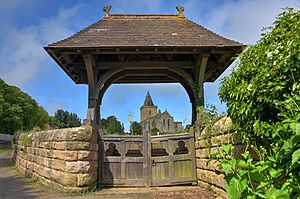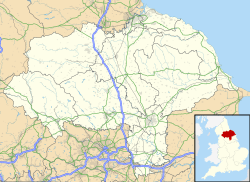Church of St Oswald, Lythe facts for kids
Quick facts for kids Church of St Oswald, Lythe |
|
|---|---|
| St Oswald's Church, Lythe | |

St. Oswald's church, Lythe, through lych-gate
|
|
| 54°30′24″N 0°41′18″W / 54.5066°N 0.6884°W | |
| OS grid reference | NZ850131 |
| Location | Lythe, North Yorkshire |
| Country | England |
| Denomination | Church of England |
| Weekly attendance | 20 |
| History | |
| Status | Active |
| Dedication | St Oswald |
| Associated people | John Fisher |
| Administration | |
| Parish | Lythe with Sandsend |
| Benefice | Hinderwell, Roxby & Staithes with Lythe, Ugthorpe & Sandsend |
| Deanery | Whitby |
| Archdeaconry | Cleveland |
| Diocese | York |
The Church of St Oswald, Lythe, is a special church in the village of Lythe. Lythe is about 4 miles (6.4 km) west-north-west of Whitby in North Yorkshire, England. The church is at the top of Lythe Bank, which is the western end of a steep hill. It sits just east of the village on the A174 road.
A church has been on this site since the 13th century. However, the building you see today was mostly changed and updated in 1910. This work was done by a famous architect named Sir Walter Tapper. The church is very important and was given a special "grade I listed" status in 1969. This means it is a building of exceptional historical interest.
Contents
History of St Oswald's Church
Early Beginnings and Viking Discoveries
A church has stood on this spot since the 1200s. But, during building work in the early 1900s, old stones were found. These stones showed that Lythe was an important Viking burial ground a very long time ago. Some stones found in the tower walls were even older than the Norman Conquest (1066).
Changes Over the Centuries
The old church tower was repaired in 1769. The whole church was then renovated again in 1819. When Sir Walter Tapper rebuilt the church in 1910, he kept only the north wall and the east end of the chancel (the part of the church near the altar). Tapper also changed the old Norman tower. He added a spire to it. This spire is tall and acts like a landmark. It helps sailors find their way along the coast, which can be dangerous.
The church was given to the monks of Nostell Priory a long time ago, between 1159 and 1181. They named it after their saint, Oswald of Northumbria. Later, in the 1530s, the church became property of the King. This happened after its supporter, Sir Francis Bigod, was executed for treason.
Before Tapper's big changes, the church, which was originally from the 12th and 13th centuries, had many updates. Walls were made stronger with supports called buttresses. Two arches inside the church were removed to make one larger arch. The very top of the tower was taken off around 1768 because people worried it might fall down. In 1818, the lead roof was replaced with slate tiles. The churchyard, which is the area around the church, was made bigger in 1887. Around the same time, a lych-gate was added. This is a covered gateway into the churchyard.
Location and Community
The church is only about 350 feet (107 meters) from the coast. It is next to a very steep hill on the A174 road, known as Lythe Bank. Its high position means it has amazing views to the east, looking over the road and the sea.
A smaller church, called St Mary's, was built in Sandsend. This happened when more people moved to Sandsend. The new church meant that people living there did not have to climb the steep Lythe Bank to get to St Oswald's.
Even though some people thought the church had lost its old value because of the 1910 changes, it was still given a Grade I listing in 1969. This shows how important it is.
In 2018, the church roof was replaced again. The old sandstone tiles that Tapper had put on were replaced with newer stones. A local artist carved the old sandstone tiles into unique artworks. These pieces were then sold during the 2019 Tour de Yorkshire cycling event. The money raised helped the church.
Churchyard and Memorials
The churchyard is the burial ground around the church. It has many graves, some of which are very old, dating back to the 10th century. Several of the graves belong to the Phipps family. This family has owned Mulgrave Castle and its surrounding woods for many hundreds of years. Oswald Phipps, 4th Marquess of Normanby, a member of this family, was buried here in 1994.
The churchyard also has a special memorial. It remembers the seventeen men from the village who died in the First World War. It also honors seven unknown sailors whose bodies washed ashore during the same time. This memorial is located to the south-west of the church. It is also a grade II listed building, meaning it is of special interest.
In 1932, a Belgian fishing boat called the Jeanne was wrecked on the coast below Lythe. The churchyard contains a grave for three of the sailors who died in that accident.
Parish and Church Area
The Church of St Oswald is the main church for the Parish of Lythe. A parish is an area that a church serves. This parish covers a large area, more than 40 square miles (104 square kilometers). It includes the villages of Lythe, Sandsend, Goldsborough, East & West Barnby, and Kettleness. The area is mostly a countryside and seaside landscape.
The church is also part of a larger group of churches called a benefice. This benefice includes Hinderwell, Roxby & Staithes with Lythe, Ugthorpe & Sandsend.
The benefice has about 2,700 people living in it. However, only 74 people regularly attend church services across all the churches. Of those, only 20 people regularly attend St Oswald's. In 2016, St Oswald's held three baptisms (welcoming new members), nine weddings, and seven funerals.
Clergy of St Oswald's
The clergy are the religious leaders of the church. Before 1537, the leaders of St Oswald's were called rectors. After that, they were called vicars. This change happened when Edward Layton became the vicar, appointed by Henry VIII.
Some records suggest that John Fisher, who was in charge between 1499 and 1504, might be the same John Fisher who became a Catholic martyr. His successor at Lythe was Hugo Ashton.
| Year | Incumbent | Year | Incumbent | Year | Incumbent | Year | Incumbent | |||
|---|---|---|---|---|---|---|---|---|---|---|
| 1154 | Robert, Priest of Lythe | 1372 | John de Gascoigne | ? | Henry Fletcher | 1902 | William G. Harland | |||
| 1233 | Hugo, Clericus | 1394 | Thomas Kellowe | 1607 | Robert Raynard | 1934 | Phillip J. Seymour Russell | |||
| 1267 | John de Toucotes | 1409 | William Gaunton | 1640 | Thomas Burrowes | 1946 | J. K. Bretherton Bennett | |||
| 1291 | Stephen de Mauley | 1416 | Richard Yorke | 1662 | William Shipton | 1949 | Dudley Joseph Hill | |||
| 1296 | Simon Clairvaux | 1417 | John Semer | 1667 | Herbert Ferreman | 1957 | Peter Richard Hodgson | |||
| 1307 | William de Melton | 1433 | Richard Langton | 1672 | William Smeathman | 1961 | Dennis Theodore Little | |||
| 1315 | Nicholas de Huggate | 1459 | Christopher Bank | 1679 | John Wiely | 1973 | John William Foster | |||
| 1318 | Thomas de Pauhale | 1481 | Thomas Artas | 1707 | Ralph Bateman | 1979 | Peter Carr Ferguson | |||
| 1319 | Richard de Milton | 1499 | John Fisher | 1737 | Thomas Gawton | 1983 | Robert Anthony Smailes | |||
| 1322 | Adam de Heselbeck | 1504 | Hugo Ashton | 1739 | Samuel Marsden | 1988 | Walter Smith | |||
| 1328 | Francis Gaytom | 1511 | John Frost | 1760 | Jonathan Robinson | 1999 | E. C. Richard Burge | |||
| 1330 | William de Wardhoue | 1516 | Thomas Larke | 1778 | William Harrison | 2006 | Barry Pike | |||
| 1343 | John de Bolton | 1523 | James Cockerell | 1780 | Thomas Porter | 2018 | Malcolm Jackson | |||
| 1370 | Thomas de Myddleton | 1537 | Edward Layton | 1826 | William Long | |||||
| 1372 | John de St John | 1544 | John Pykering | 1858 | Henry R. S. Pearson |
See also
- Grade I listed buildings in North Yorkshire (district)
- Listed buildings in Lythe


